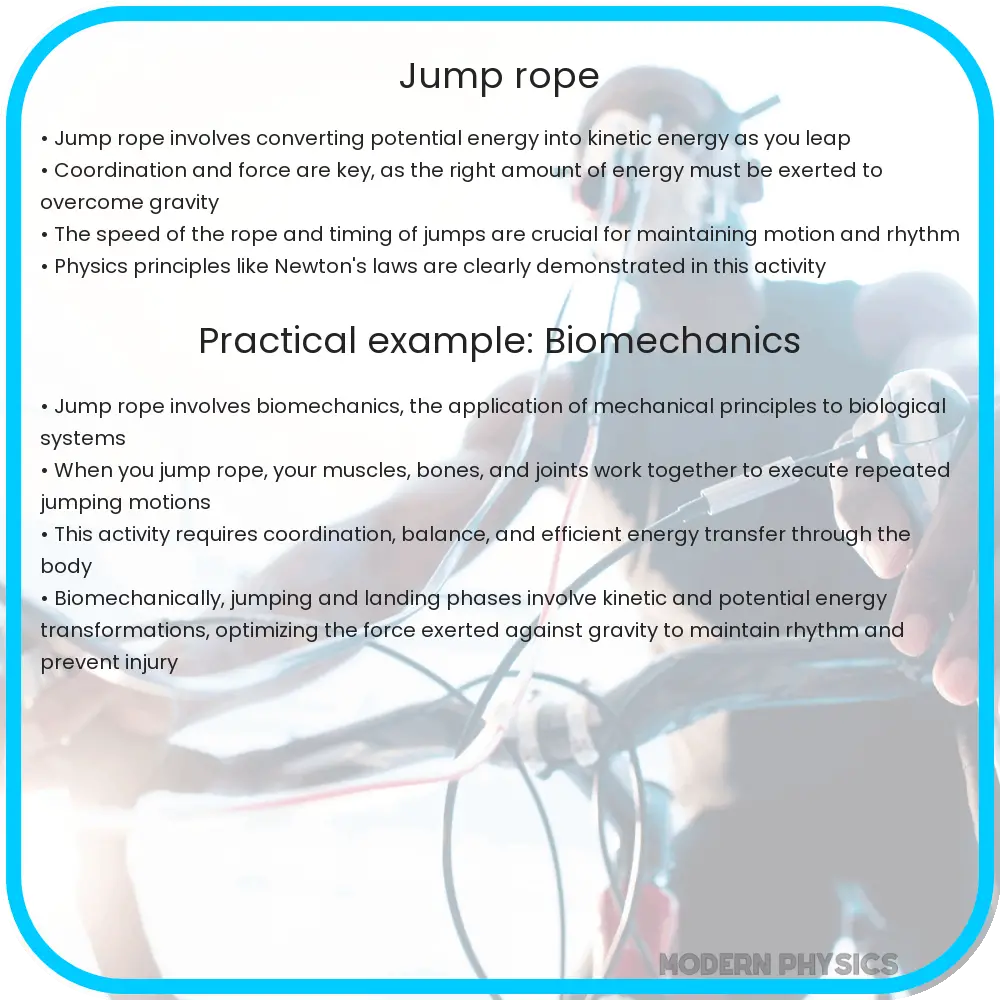Explore the physics of jump roping in this insightful article, uncovering the mechanics

Jump Rope Dynamics: Understanding Mechanics, Momentum, and Force
The seemingly simple activity of jump roping encompasses a complex interplay of mechanics, momentum, and force. This article delves into the physics behind jump roping, offering insights into how these principles govern the motion and efficiency of this popular exercise and sport.
Mechanical Principles in Jump Roping
At its core, jump roping involves converting kinetic energy (motion) into potential energy (position) and vice versa. The rope’s movement is a perfect example of rotational motion, where every point on the rope traces a circular path. The primary forces at play include tension in the rope, gravity acting on the rope and the jumper, and the force applied by the jumper to initiate and sustain the motion.
Momentum and Its Conservation
Momentum, a product of mass and velocity, is a key component in understanding jump rope dynamics. As the jumper swings the rope, they impart momentum to it, which is conserved as the rope travels in an arc. This conservation of momentum is crucial for maintaining a steady rhythm and speed during jumping.
Centripetal Force in Action
The centripetal force, directed towards the center of the rope’s circular path, is responsible for keeping the rope taut and in motion. This force is not an additional force applied but rather a result of the tension in the rope combined with the gravitational force acting on the rope’s mass.
Energy Transfer Efficiency
Efficiency in jump roping is largely about minimizing energy loss. The energy the jumper puts into the system is not only used to keep the rope moving but also to overcome air resistance and any friction in the rope’s rotation points. A well-designed jump rope minimizes these energy losses, allowing for smoother and more efficient movement.
Impact of Rope Length and Material
The length and material of the rope significantly affect its dynamics. A longer rope requires more force to maintain the same rotational speed due to increased air resistance and weight. Conversely, a shorter rope can spin faster with less effort but requires more precision in timing. The material of the rope also plays a crucial role in how it interacts with air resistance and the force required to maintain motion.
Jump roping, therefore, is not just a physical exercise but also a fascinating demonstration of physics in action. Understanding these principles can enhance one’s technique and efficiency in this activity.
The Role of Gravity and Air Resistance
Gravity plays a constant role in jump roping, affecting both the jumper and the rope. Each jump must overcome gravitational pull, while the downward force helps in bringing the jumper and the rope back to the ground. This interplay is crucial for timing and rhythm. Air resistance, albeit less significant, still impacts the rope’s motion, particularly at higher speeds where the air resistance is more pronounced.
Biomechanics of the Jumper
The jumper’s biomechanics, including posture, jump height, and arm movement, significantly influence the dynamics of jump roping. Efficient movement reduces unnecessary energy expenditure, while proper posture and arm positioning can greatly affect the tension and speed of the rope. The coordination between arm and leg movements is essential for maintaining rhythm and controlling the rope’s speed and height.
Angular Momentum and Its Effects
Angular momentum, a counterpart to linear momentum, is evident in the rotating motion of the jump rope. It is conserved unless acted upon by an external torque. This principle explains why a faster-spinning rope tends to maintain its speed, requiring less effort to keep it moving, whereas a slow-moving rope requires constant input to stay in motion.
Practical Applications in Exercise and Training
Understanding the mechanics of jump roping can enhance training and exercise routines. For athletes, manipulating these dynamics can aid in developing speed, timing, and coordination. Fitness enthusiasts can adjust their technique for a more effective workout, focusing on the interplay between force, momentum, and energy conservation.
Conclusion
Jump roping is more than a simple exercise; it’s a complex interplay of physics and biomechanics. The dynamics of mechanics, momentum, and force play integral roles in every aspect of the activity. By understanding these principles, one can appreciate the sophistication behind this seemingly simple exercise and use this knowledge to improve their technique, efficiency, and overall performance in jump roping. Whether for fitness, sport, or pleasure, the science behind the rope offers a deeper understanding and a more rewarding experience.
